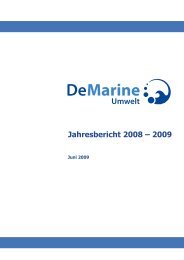CLOUD STRUCTURES - Brockmann Consult
CLOUD STRUCTURES - Brockmann Consult
CLOUD STRUCTURES - Brockmann Consult
Create successful ePaper yourself
Turn your PDF publications into a flip-book with our unique Google optimized e-Paper software.
Introduction 12<br />
Introduction<br />
Hamlet<br />
Do you see yonder cloud that's almost in shape of a camel?<br />
Polonius<br />
By the mass, and 'tis like a camel indeed.<br />
Hamlet<br />
Methinks it is like a weasel.<br />
Polonius<br />
It is backed like a weasel.<br />
Hamlet<br />
Or like a whale.<br />
Polonius<br />
Very like a whale.<br />
William Shakespeare: Hamlet, Prince of Denmark: ACT III. Scene II<br />
Clouds are the most mobile and changeable structure in the aspect of our live planet. Approaching the Earth it is<br />
impossible to look over their deversity, complexity and striking beauty.<br />
The following work is to describe some cloud formations over the ocean as well as present examples of some of<br />
the most frequently found cloud structures.<br />
The work includes the analysis of the notion "a cloud structure" (also known as "a cloud pattern"), the<br />
description of these structures, some of inherent physical parameters thereof, the statistics on allocation and a<br />
wide range of images.<br />
The data that was received during many years from the MERIS - a programmable, medium-spectral resolution,<br />
imaging spectrometer installed on the ESA's satellite ENVISAT served as the source material; the Software<br />
BEAM VISAT developed by the <strong>Brockmann</strong> <strong>Consult</strong>, Germany, was used as the basic tool.<br />
The work was conducted at the <strong>Brockmann</strong> <strong>Consult</strong>, Germany, within the framework of the "Image of the Day"<br />
project.<br />
The Cloud Structures (CS)<br />
While observing the Earth from the height of 500-5000 km it is possible to notice that the cloudy envelope of<br />
the planet is a ranked rather than a chaotic accumulation of clouds as far as it concerns their forms. These forms<br />
either repeat themselves or differ but in any event they reflect definite process taking place in the atmosphere.<br />
The outward appearance of CS remains invariable within a year and on the whole does not depend on their<br />
geographical location.<br />
All this allows to try to unify them on the base of appropriate criteria and thus to speak about the cloud<br />
structures and systemize them.<br />
In this work a "cloud structure" means a compact cloud formation of a distinct spatial form with the dimensions<br />
of more than 10-20 km and reflecting a definite state of the atmosphere and the underlying surface.<br />
Very often some CSs may be associated to these or that geographic realities. Formation and expansion of CSs<br />
also depend on the season. Some CSs consolidate in large mega structures (MCS). Most of CSs are so large, that<br />
to observe them from the surface of the Earth or from one side, for example from the board of an airplane,<br />
means to obtain an incomplete picture.<br />
<strong>Brockmann</strong> <strong>Consult</strong> © 2010




